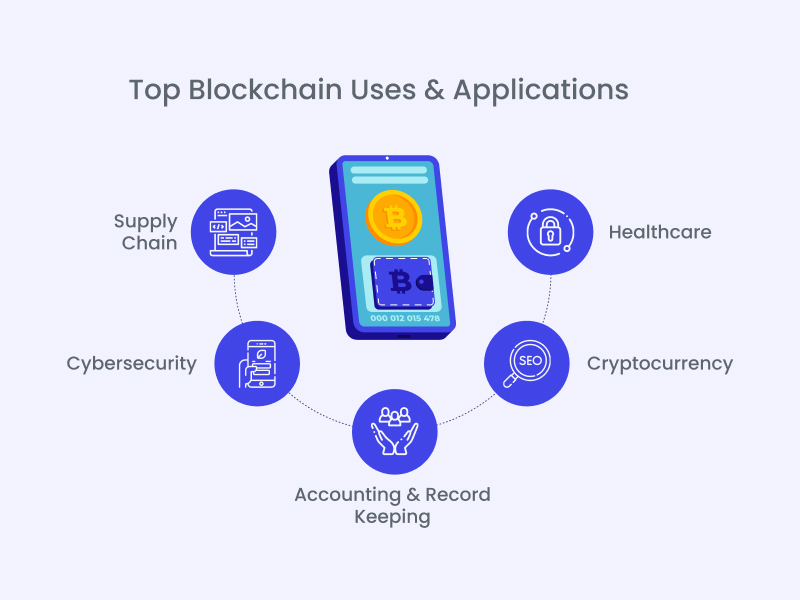What is Blockchain Technology?
At its core, blockchain is a distributed ledger technology that records transactions across a network of computers. Each transaction is stored in a “block,” and these blocks are linked together in a chronological “chain.” The technology is decentralized, meaning that no single entity controls the entire chain, and it is highly secure due to cryptographic hashing.
Key Features of Blockchain:
- Decentralization: Eliminates the need for a central authority, such as banks or governing bodies.
- Transparency: Every participant in the network has access to the same version of the ledger, promoting transparency.
- Security: Transactions are encrypted and linked, making it difficult to alter or hack the data.
- Immutability: Once a transaction is recorded, it cannot be changed or deleted.
Applications of Blockchain Technology
Blockchain’s unique characteristics make it suitable for a variety of applications, from financial services to supply chain management. Here are some of the most promising use cases:

1. Financial Services and Cryptocurrencies
One of the most well-known applications of blockchain is in financial services, particularly through cryptocurrencies like Bitcoin and Ethereum. Blockchain enables peer-to-peer transactions without the need for intermediaries, reducing transaction fees and processing times.
Applications in Financial Services:
- Cross-Border Payments: Blockchain facilitates faster and cheaper cross-border transactions compared to traditional banking systems.
- Smart Contracts: Self-executing contracts with the terms directly written into code, eliminating the need for intermediaries.
- Decentralized Finance (DeFi): A financial ecosystem that uses blockchain technology to offer services like lending, borrowing, and trading without traditional banks.
2. Supply Chain Management
Blockchain improves transparency and traceability in supply chains by recording every transaction and product movement. This makes it easier to track the origin of goods, ensure product authenticity, and reduce fraud.
Benefits in Supply Chain:
- Enhanced Traceability: Companies can trace products from their origin to the consumer, ensuring quality and ethical sourcing.
- Fraud Prevention: Immutable records reduce the risk of fraud and counterfeiting.
- Streamlined Operations: Automates documentation and reduces delays in the supply chain.
Example: Walmart uses blockchain to track the origin of produce, ensuring food safety and quickly identifying contaminated batches.

3. Healthcare
Blockchain can address many challenges in healthcare, such as data security, interoperability, and patient record management. It allows for secure and tamper-proof medical records while giving patients more control over their health data.
Applications in Healthcare:
- Patient Data Management: Blockchain securely stores patient records, ensuring that only authorized individuals can access them.
- Drug Traceability: Tracks the entire supply chain of pharmaceuticals to combat counterfeit drugs.
- Clinical Trials: Increases transparency in clinical trials by ensuring that data cannot be manipulated or altered.
Example: Companies like Medicalchain are using blockchain to give patients ownership of their medical records, improving security and accessibility.
4. Voting Systems
Blockchain technology can enhance the transparency and security of voting systems. By creating an immutable ledger of votes, it ensures that elections are tamper-proof and transparent, reducing the risk of electoral fraud.
Benefits of Blockchain in Voting:
- Transparency: Voters can verify that their votes were counted without revealing their identity.
- Security: Prevents tampering and hacking of election results.
- Accessibility: Enables secure online voting, making it easier for people to participate in elections.
5. Real Estate
In the real estate industry, blockchain can simplify the process of buying and selling properties by eliminating the need for intermediaries, such as brokers and banks. It also offers a secure and transparent way to manage property records.
Applications in Real Estate:
- Property Transactions: Smart contracts automate property transfers and reduce paperwork.
- Land Registry: A tamper-proof ledger that records property ownership and transaction history.
- Fractional Ownership: Blockchain allows investors to buy fractions of a property, opening real estate investment to a broader audience.
Example: Propy, a blockchain-based real estate platform, facilitates the buying and selling of properties using smart contracts.
6. Intellectual Property and Copyright Protection
Blockchain provides a secure way to record and manage intellectual property rights, ensuring that creators are properly credited and compensated for their work. It also simplifies the process of licensing and transferring rights.
Applications in Intellectual Property:
- Digital Rights Management: Artists and creators can register their work on the blockchain, proving ownership and usage rights.
- Royalty Payments: Smart contracts automate royalty payments, ensuring creators are paid when their work is used.
Example: The music industry is exploring blockchain to ensure artists receive fair compensation for streams and downloads.
Backbone Of Computer Communications![]()
Challenges of Blockchain Technology
Despite its potential, blockchain technology faces several challenges that must be overcome for widespread adoption:
1. Scalability
Blockchain networks, especially those like Bitcoin and Ethereum, face scalability issues. As more transactions are added to the blockchain, the network can become slow and expensive. Current solutions, such as the Lightning Network for Bitcoin, aim to address these issues, but scalability remains a challenge.
Example: Ethereum’s transition to Ethereum 2.0 is an effort to improve scalability and reduce transaction fees.
2. Energy Consumption
Blockchain, particularly proof-of-work (PoW) systems like Bitcoin, require significant computational power, consuming large amounts of energy. This raises environmental concerns and questions about the sustainability of blockchain networks.
Possible Solutions: Moving to more energy-efficient consensus mechanisms, such as proof-of-stake (PoS), could help reduce energy consumption.
3. Regulatory and Legal Issues
Blockchain operates across borders, creating regulatory challenges. Governments around the world are still developing frameworks for cryptocurrencies, smart contracts, and other blockchain applications. The lack of clear regulations can hinder innovation and adoption.
Example: Countries like China have implemented strict regulations on cryptocurrencies, while others like El Salvador have embraced Bitcoin as legal tender.
4. Data Privacy Concerns
While blockchain offers transparency, it also raises concerns about data privacy. Public blockchains are accessible to anyone, which can be problematic when sensitive information is involved. Finding a balance between transparency and privacy remains a challenge.
Potential Solutions: Using private or permissioned blockchains and implementing encryption techniques to protect sensitive data.
5. Integration with Existing Systems
Integrating blockchain with existing legacy systems can be complex and expensive. Businesses must invest in new infrastructure and train their employees, which can be a barrier to adoption, especially for smaller organizations.
Example: Financial institutions face challenges in integrating blockchain with traditional banking systems, which often require significant overhauls.
6. User Adoption and Understanding
Blockchain technology is still relatively new and complex, making it difficult for the general public to understand and adopt. For widespread use, businesses and developers must focus on creating user-friendly interfaces and educating consumers about the benefits of blockchain.
Computer Protection Essentials![]()


Conclusion: The Future of Blockchain Technology
Blockchain technology holds immense potential to revolutionize industries by providing secure, transparent, and efficient solutions. From financial services and supply chain management to healthcare and voting systems, the applications of blockchain are vast and varied. However, challenges such as scalability, energy consumption, and regulatory hurdles must be addressed to unlock its full potential.
https://youtu.be/4K-NkW8piog?si=sx8zaJrg4iDyCXOY
As the technology matures and solutions to these challenges are developed, we can expect to see even more innovative use cases emerge. For businesses and individuals, staying informed about blockchain advancements is key to understanding how this transformative technology will shape the future.




Leave a Reply